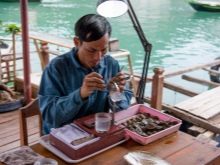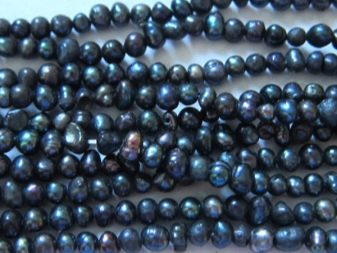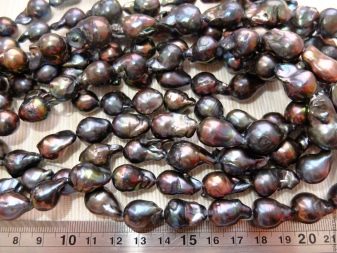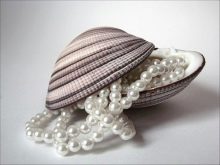How much are pearls worth?

Natural pearls, which were mined from shellfish in India, China, Iran (Persia) and Rome, were used as bargaining chips more than forty centuries ago. Large-sized pearls of regular shape and pearl balls of rare and exotic colors were especially highly valued: black, pink, emerald, blue, violet, apricot, purple, aqua. Later, when ingots and nuggets of gold became the monetary equivalent, smart jewelers very quickly "adapted" to the changed situation and began to make expensive necklaces, beads, rhinestones, pendants, pendants from mother-of-pearl seafood.


World market value
In some cases, experienced jewelers and suppliers cannot conclusively explain the reason for the difference in price of the same type of natural pearls in different countries. According to experts and marketers, the market price of pearl pearls is formed depending on:
- labor costs for growing shellfish;
- the value of the metal (gold, silver or platinum), from which jewelry with pearls is made, with the exception of beads, rhinestones and necklaces;
- the distance from the place where the pearl beads were grown to the point of sale;
- the amount of customs fees;
- the cost of maintaining the store and the greed of the seller.


In Russia, jewelry made from sea round pearls without other precious stones cost more than 28 thousand rubles. If the beads are uneven, then you will need to pay about 12-15 thousand rubles for the necklace. A bracelet made of sea pearls with a flat surface costs about 6,000 rubles, a similar jewelry made of uneven pearls is estimated at 3,000 rubles. River pearl beads and necklaces cost half the price.



In the Philippines, natural pearls raised from the bottom of the sea start at 40,000 pesos ($ 900) per strand. Pearls from pearl farms start at 150 pesos ($ 11).
The price of one natural pearl, which grew in the waters of the Red Sea, in the Persian Gulf or off the coast of Japan and Sri Lanka, ranges from $ 1,000 to $ 10,000.
The price of one gem-quality pearl produced by the Imperial Jewelry House from Japan and Misaki from Osaka in Moscow stores starts from 2500 rubles.
The main part of the price of pearl jewelry, if we are not talking about beads, necklaces or bracelets, is the cost of metal - gold, silver or platinum. Often, manufacturers, seeking to make a profit at any cost, insert rough or low quality pearls into jewelry made of expensive metal, along with emeralds, zircons, diamonds and other natural gemstones.



Dishonest jewelry sellers use fake pearlescent beads made of plastic with metal spraying to advertise and sell a number of professional tricks for manipulating the substitution of concepts:
- lack of a clear pearl classification system;
- slight difference in cost compared to natural pearls;
- the use of companies and brands consonant in the name;
- packaging similar in appearance to a well-known brand;
- an imperceptible difference in the quality of the stone surface treatment during external examination;
- by their appearance, it is impossible to determine the origin of pearls: sea, river, or grown on special farms;
- volatility of prices for pearl jewelry: holiday discounts, promotions and sales;
- there is no hallmark on pearls.
The question of whether it is possible to consider a precious stone that has grown inside a mollusk from a quartz grain of sand in a pool of sea water, experts refer to the real one as rhetorical.

According to scientific canons, the authenticity of a precious mother-of-pearl stone is determined by the conditions in which it grew:
- if the pearl has grown inside a mollusk at the bottom of the ocean or in an artificial reservoir with sea water - a natural stone;
- if the ball is beautifully painted and polished to a mirror shine plastic, which is covered with mother-of-pearl varnish on the outside - the pearl is fake.


Some countries with long coastlines use the pearl trade (natural and grown in shallow waters) as one of their main sources of funding.
In Vietnam, there are special farms for the cultivation of cultured pearls. In special cages in warm shallow waters in the ocean, they breed a mollusk - pearl mussel.
Upon reaching the size of the valves of about 5 centimeters, several small crystals of quartz sand are introduced into the body of the mollusks and sent back to the cages for the maturation of the artificial jewel.
After 9 months, a ripe pearl about a centimeter in size is removed from the mollusk.
To obtain a color that is different from the natural milky white, the mollusks are settled in special aquariums with sea water, to which copper sulfate, salts of chromium, cobalt, phosphorus, nickel, zinc are added.



In Thailand, in shallow water warmed by the sun, three types of gemstone "from a grain of sand" are grown:
- akoya;
- mabi;
- South Sea.


Pearls differ in shape, size and color. The nacreous ball, which grew from a grain of quartz in Thailand, comes in white, black, pink and golden yellow colors.
The most popular gift that tourists usually bring home as a souvenir from Nha Trang (Vietnam) is a mother-of-pearl ball that has grown inside a clam. There is a shop near the Cham Towers with inexpensive items made from natural shiny mother-of-pearl balls.
It is very easy to distinguish a fake from a natural stone: you need to rub the mother-of-pearl balls together over a sheet of white paper with a little effort.
If the varnish does not crumble from the surface of the balls and the hands remain clean, then the jewel is natural.
Fukuoka is home to a pearl processing factory and one of Vietnam's largest branded stores selling jewelry made from shellfish. The factory and shop are located near the local airport, which creates additional convenience for tourists.


A pearl farm and the Hainan Jingrun Pearl Museum of the same name appeared in Hainan (Sanya) in 1997. Employees and scientists at the farm investigated the process of growing pearls from the moment the quartz sand gets inside the shell to the moment the finished product leaves the conveyor. From the first days the company had an impeccable reputation. People from Southeast Asia and China still come to the store of this company to buy pearl products. When visiting the museum, the guide talks about the methods of growing pearls on plantations and the nuances of this process. In the course of the story, a demonstration of the processing of mother-of-pearl jewelry is made.
After the museum, tourists find themselves in a small shop where jewelry, figurines and cosmetics made with pearl dust are constantly sold at very low prices.
When purchasing multiple items of shiny mother-of-pearl beads, the customer gets a big discount.


Phuket (Thailand) is home to one of the largest pearl cage factories. Thanks to the producers' know-how (high water temperature in shallow water and mineral feeding), a pearl with a diameter of about a centimeter grows from a quartz grain in the body of a mollusk in two years. On this island two factories are engaged in breeding pearl mussels and making jewelry from them: Phuket Pearl Art Factory and Amorn Pearl Phuket.

Pearls were first cultivated in Kazakhstan in 2012 on plantations in the Esil River valley (near the city of Astana). For three years, a pearl with a diameter of about 7 millimeters ripens from a fragment of a shell inside a mollusk. In the Kazakh “harvest of pearls” from the plantation, there are a lot of balls of dark gray and black with a dark lilac sheen. Experts explain the rapid maturation of mother-of-pearl balls and a rare color range by the presence of salts, a large amount of molybdenum and radioactive isotopes in river water.


How to distinguish from a fake?
A natural jewel can be very easily distinguished from a fake one in a few seconds, without leaving the seller's counter. To carry out an "instant examination", you need to take with you a piece of dark suede (preferably black). The pearl is taken in hand and several times with an effort, the ball is passed over a dry piece of suede. If shiny stripes from pearl lacquer remain on the fabric, then the pearls are fake.
A careful visual inspection in reflected light will also help to identify a fake.
If examination reveals thickening of the varnish that looks like an old stool painted with a brush, the pearl is fake.
Another sure sign of man-made pearls is the chipped and uneven edges of the thread hole in the mother-of-pearl ball.


Natural pearls are much heavier than their plastic imitation; when dropped from a small height, they do not bounce off the surface like a plastic ball.
Imitation lacquered plastic mother-of-pearl dissolves in concentrated acetic acid. If you moisten a cloth or cotton wool in the vinegar essence and wipe the suspicious products, the pearl lacquer will dissolve on the artificial balls and a “naked” plastic ball will become visible. A significant drawback of this barbaric verification method is that fake beads or necklaces, in case of failure, will no longer be worn, they will need to be thrown away.

Prices in Russia
In Russia, a large necklace made of natural sea pearls weighing 250 grams, which has not been touched by a human hand in the process of origin and maturation, is estimated at 55,000 dollars, from those grown on plantations in the sea - 5500 dollars,from those grown on plantations in rivers - 1100 dollars. One rough gem-quality pearl 10 mm in diameter costs about $ 400 before being processed by a jeweler.

The cost of one natural pearl, which has not been touched by a human hand, in the world market depends on the type and place of extraction. According to data from open sources, the market price for natural mother-of-pearl was within:
- natural pearls from plantations in the Indian Ocean and the Persian Gulf - from $ 1,000 to $ 10,000;
- cultured artificial pearls from the same plantations - from 100 to 600 dollars, black pearls - up to 1000 dollars;
- cultured freshwater pearls - $ 20 to $ 100
Prices in specialized salons and shops with guaranteed authenticity and quality of products for beads, necklaces, necklaces, rhinestones and other products made of mother-of-pearl stone (on the eve of New Year's holidays, March 8, Valentine's Day) and during promotions are significantly lower than market prices. For this reason, it is better to buy pearl jewelry at this time.


Jewelry value
Jewelry with pearls is very much appreciated by their owners. There are several reasons for this:
- affordable price for one bead or thread of mother-of-pearl jewelry;
- appearance of the stone: shine, resistance to mechanical damage in case of accidental fall;
- the need to comply with certain conditions in the process of using the necklace and the need for periodic special care: washing with soapy water, lubricating the surface with fat, polishing with a woolen cloth, which are not particularly difficult.



For more information on pearls, their properties and history, see below.









Hello, I want to understand: have I found pearls.